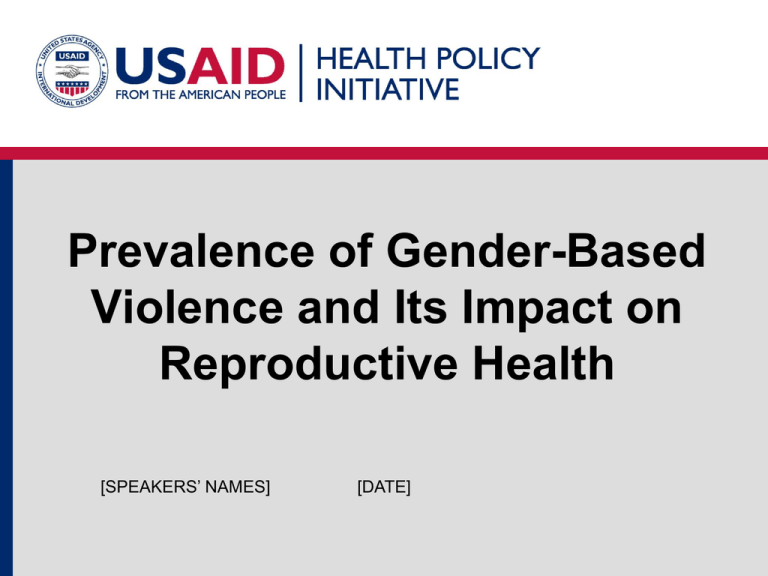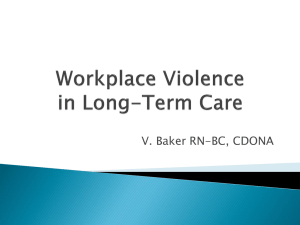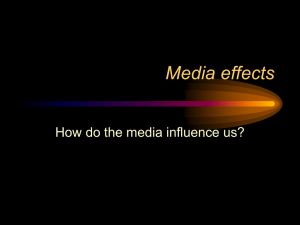
Prevalence of Gender-Based
Violence and Its Impact on
Reproductive Health
[SPEAKERS’ NAMES]
[DATE]
Part I: Prevalence of GBV
Prevalence of GBV
Intimate partner violence (IPV) is prevalent
worldwide:
A WHO study conducted in 10 countries found
that between 15% and 71% of women experience
some form of IPV at some point in their lives; in
most countries prevalence estimates range from
30% to 60%.
In most countries 20-33% of women reported IPV
within the past 12 months.
Source: Garcia-Moreno et al., 2005
Prevalence of GBV: Intimate Partner Physical and
Sexual Violence
75%
52%
48%
42%
32%
33%
27%
19%
20%
16%
Source: Hindin et al., 2008
Prevalence of GBV: Intimate Partner Physical
and Sexual Violence
60
Prevalence of physical or sexual violence, or both, by intimate
partner among ever-partnered women, within the past 12 months,
by site
54%
40
34%
32%
29%
30
23%
20
15%
10
zil
Br
a
d
Th
ai
la
n
ni
a
Ta
n
of
UR
Ba
n
gl
ad
za
es
h
u
Pe
r
io
p
ia
0
Et
h
Percentage
50
Source: Garcia-Moreno et al., 2005
Prevalence of GBV: Intimate Partner Physical
Violence
• The WHO study found that, of ever-partnered
women, 13%-61% experience physical
violence at some point in their lives.
• Most study sites found a prevalence of 23%49% of physical IPV.
Source: Garcia-Moreno et al., 2005
Prevalence of GBV: Sexual Violence
•The WHO study found that 6% to 59% of women
reported experience of sexual violence at some point in
their lives, with most sites within the 10% to 50% range
•1% to 44% of women experienced sexual violence in
the 12 months prior to the study
Source: Garcia-Moreno et al., 2005
Prevalence of GBV: Sexual Violence
Percentage of women reporting forced 1st experience of
sexual intercourse among sexually experienced women
35
29%
23.6%
25
20
16.6%
26.6%
15
10
5.3 %
4.3%
5
ia
d
U
R
.o
fT
Th
ai
an
z
an
la
n
er
u
op
i
th
i
P
a
il
B
ra
z
E
an
gl
ad
es
h
0
B
Percentage
30
Source: Garcia- Moreno et al. 2005
Part II: Impact of GBV on
Reproductive Health
Health Consequences of GBV
Fatal Outcomes
Non-fatal Outcomes
•Femicide
•Suicide
•AIDS-related
Physical
Sexual &
Reproductive
Psychological &
Behavioral
mortality
•Maternal
mortality
•Fractures
•Chronic pain
•Sexually-transmitted
•Depression and
infections, including
HIV
syndromes
•Unintended pregnancy
•Fibromyalgia
•Pregnancy
•Permanent
complications
disability
•Gastro-intestinal •Traumatic gynecologic
fistula
disorders
•Abortion complications
anxiety
•Eating and sleep
disorders
•Drug and alcohol
abuse
•Poor self-esteem
•Post-traumatic
stress disorder
•Self-harm
Source: Adapted from Bott, Morrison, and Ellsberg, 2005.
GBV Is a Public Health Issue
Source: Heise et al.,1994.
Health Consequences of GBV
Percentage of women who report health outcomes as a consequence
of acts carried out by their husbands or partners
Source: Dominican Republic Demographic and Health Survey, 2000, cited in Kishor and Johnson,
2004.
GBV Has Severe Reproductive Health Impacts
• Violence during pregnancy
– Intimate partner violence prevalence of 4-15% during
pregnancy
– Leading cause of death among pregnant women may be
homicide
GBV Has Severe Reproductive Health Impacts
(continued)
• Violence and HIV/AIDS
– Low relationship power and intimate partner violence
increase risk of incident HIV infection
– Forced sex is correlated to HIV risk
– Victims of violence tend to engage in behaviors that put their
health at risk
– Proposing condom use may increase women’s risk of
violence
– Disclosing HIV status may increase risk of violence
“It is said that we were all born under a
star; when I watch the stars at night I
ask which of them is mine, so that I can
change it for another one.”
--Survivor of GBV, Peru
(in Velzeboer et al., 2003)
References
Bott, S., A. Morrison, and M. Ellsberg. 2005. Preventing and Responding to Gender-based
Violence in Middle and Low-income Countries: A Global Review and Analysis. World
Bank Policy Research Working Paper 3618. Washington, DC: World Bank.
Campbell, J.C. 2002. “Health Consequences of Intimate Partner Violence.” Lancet
359(9314): 1331–1336.
Campbell, J.C., and K. L. Soeken. 1999. “Forced Sex and Intimate Partner Violence:
Effects on Women’s Risk and Women’s Health.” Violence Against Women 5(9): 1017–
1035.
Coker A., P. Smith, L. Bethea, M. King, and R. McKeown. 2000. “Physical Health
Consequences of Physical and Psychological Intimate Partner Violence.” Archives of
Family Medicines 9(5): 451–457.
Garcia-Moreno, Claudia. Henrica, A.F.M. Ellsberg, M.E. Heise, L. Watts, C. 2005. “WHO
Multi-Country Study on Women’s Health and Domestic Violence Against Women.”
Geneva, Switzerland: WHO.
References, continued
Gielen, A.C., P.J. O’Campo, J.C. Campbell, J. Schollenberger, A.B. Woods, A.S. Jones,
J.A. Dienemann, J. Kub, and E.C. Wynee. 2000. “Women’s Opinions About Domestic
Violence Screening and Mandatory Reporting.” American Journal of Preventive
Medicine 19(4): 279–285.
Heise, Lori, Jacqueline Pitanguy, and Adrienne Germain. 1994. “Violence against Women:
The Hidden Health Burden.” World Bank Discussion Paper No. 255. Washington, DC:
World Bank.
Heise, L., M. Ellsberg, and M. Gottemoeller. 1999. “Ending Violence Against Women.”
Population Reports XXVII (Number 4, Series L, Number 11).
Hindin, Michelle J., S. Kishor, and D.L. Ansara. 2008. “Intimate Partner Violence Among
Couples in 10 DHS Countries: Predictors and Health Outcomes.” Calverton, MD:
USAID.
Horon, Isabelle. 2001. “Enhanced Surveillance for Pregnancy-Related Mortality: Maryland,
1993–1998.” Journal of the American Medical Association 285:1455–459.
References, continued
Jewkes, R.J., K.Dunkle, M. Nduna, and N. Shai. 2010. “Intimate Partner Violence,
Relationship Power Inequity, and Incidence of HIV Infection in Young Women in South
Africa: A Cohort Study.” Lancet Early Online Publication, 16 June 2010.
Jewkes, R., C. Vundule, F. Maforah, and E. Jordaan. 2001. “Relationship Dynamics and
Adolescent Pregnancy in South Africa.” Social Science and Medicine 52(5):733–744.
Kishor, S. and K. Johnson, 2004, Profiling Domestic Violence – A Multi-Country Study.
Calverton, Maryland: ORC Macro.
Letorneau, E., M. Holmes, and J. Chasedunn-Roark. 1999. “Gynecologic Health
Consequences to Victims of Interpersonal Violence.” Women’s Health Issues 9(2):
115–120.
Maman, S., J. Campbell, M. Sweat, and A. Gielen. 2000. “The Intersections of HIV and
Violence: Directions for Future Research and Interventions.” Social Science and
Medicine 50: 459–478.
Maman, S., J. Mbwambo, J. Campbell, M. Hogan, G. Kilonzo, E. Weiss, and M. Sweat.
2002. “HIV- 1 Positive Women Report More Lifetime Experiences with Violence:
Findings from a Voluntary HIV-1 Counseling and Testing Clinic in Dar es Salaam,
Tanzania.” American Journal of Public Health 92(8): 1331-1337.
References, continued
Muhajarine, N., and C. D’Arcy. 1999. “Physical Abuse During Pregnancy: Prevalence
and Risk Factors.”Canadian Medical Association Journal 160: 1007–1011.
Murphy, C.C., B. Schei, T.L. Myhr, and J. Du Mont. 2001. “Abuse: a Risk Factor for
Low Birth Weight? A Systematic Review and Meta-Analysis.” Canadian Medical
Association Journal 164(11): 1567–72.
Velzeboer, M., M. Ellsberg, C. Arcas, and C. Garcia-Moreno. 2003. Violence Against
Women: The Health Sector Responds. Washington, DC: Pan-American Health
Organization (PAHO).
Thank You!









